Student-Run Middle School Broadcast Media Program
When my principal asked me and a colleague, history teacher Isaac Raya, if we’d like to take over our middle school’s daily live news show, we jumped at the opportunity. We were both pioneering 1:1 laptop classrooms, and we knew the great potential of kids working in a genuine media production program. But within a week of our new adventure, we knew its current model wasn’t sustainable, and we started lobbying our principal for some changes.
Our school’s news show started in 1999 when a couple of teachers and the librarian set up a tiny studio where a handful of students met before school each day to broadcast the daily announcements. It was an exciting early foray into media production before cell phones, laptops, or tablets appeared in our classrooms. But by the time Isaac and I took over the program, our students were filming movies on their cell phones and we were using green screens in our classrooms. We knew that for our students to really benefit from this broadcast media experience, they needed to be creating the content for the daily show and learning how to operate the technology. But since our show was prepped and broadcast in the 10 minutes before school started, we didn’t have a dedicated time or space for the students to do the behind-the-scenes work of the production.
Thanks to our visionary principal, Emily Todd, and a generous $20,000 grant from Educator/Innovator (the National Writing Project, the John D. and Catherine T. MacArthur Foundation, and John Legend’s Show Me Campaign), our before-school club was transformed into two class sections of broadcast media, giving 64 students hands-on experience producing a daily news show.
These resources are here to give you an idea of what our program looks like, how we run the daily class, the kinds of equipment we use, and how we continue to tweak and revise the program as we learn from our mistakes.
Evolution of an Experiment: The Kids are Running the Show!
My teaching colleague Isaac Raya and I spent the summer of 2015 getting ready to welcome students to our new broadcast media classroom. We moved our cameras, lights, and tri-caster from our old studio into our new classroom, and painted a green screen in a corner wall.
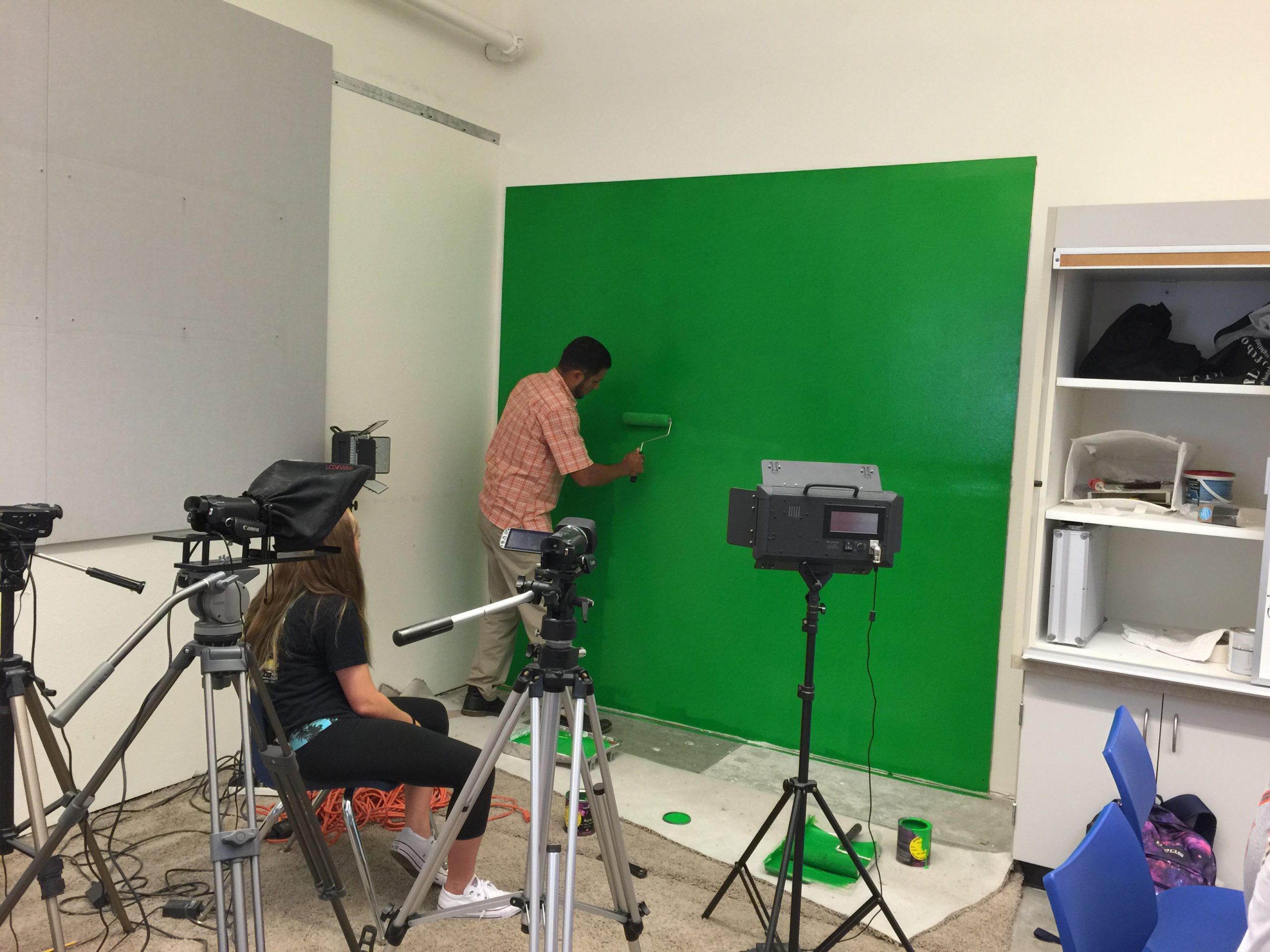
As we worked, we brainstormed how this new class would operate. There was a variety of jobs that needed to be completed for each show’s production, and with 32 students in a class, we weren’t sure how we would keep all students on-task for a full 90-minute class period.
Since some students would be writing the show’s script, some would be creating graphics, some would be filming/editing movies, and others would be working the technology during the show, we couldn’t teach them all the jobs at the same time. We decided to create a central hub where students would access the resources and directions needed for each job. This hub took the form of a class website, which we have made available to anyone interested in seeing how we run our class. We also created a job board, where students could check in to see their responsibilities for the day (students keep the same job for three weeks, giving them time to learn each job well enough that they can teach another student).
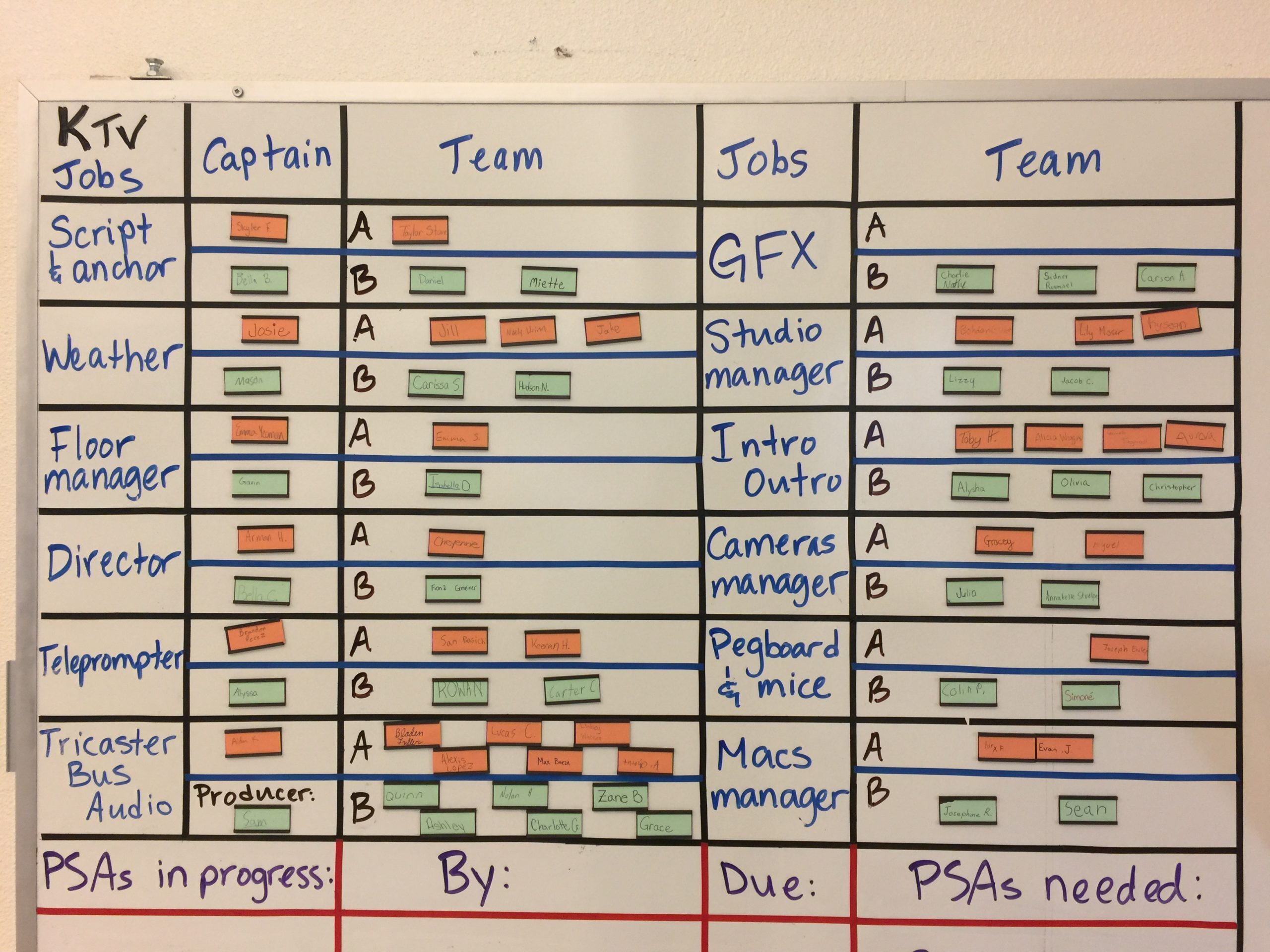
If you were to walk into our studio during class time, you might sense a bit of chaos. Students are scattered throughout the room: some seated at tables with laptops, some working with studio equipment, some outside filming, some huddled in groups brainstorming. Since the teacher can’t be at every station, answering questions for every job, the students learn to turn to each other for help. They know they can find answers on our website, but they also discover which students are experts in which area, and they learn to collaborate to get the jobs done.
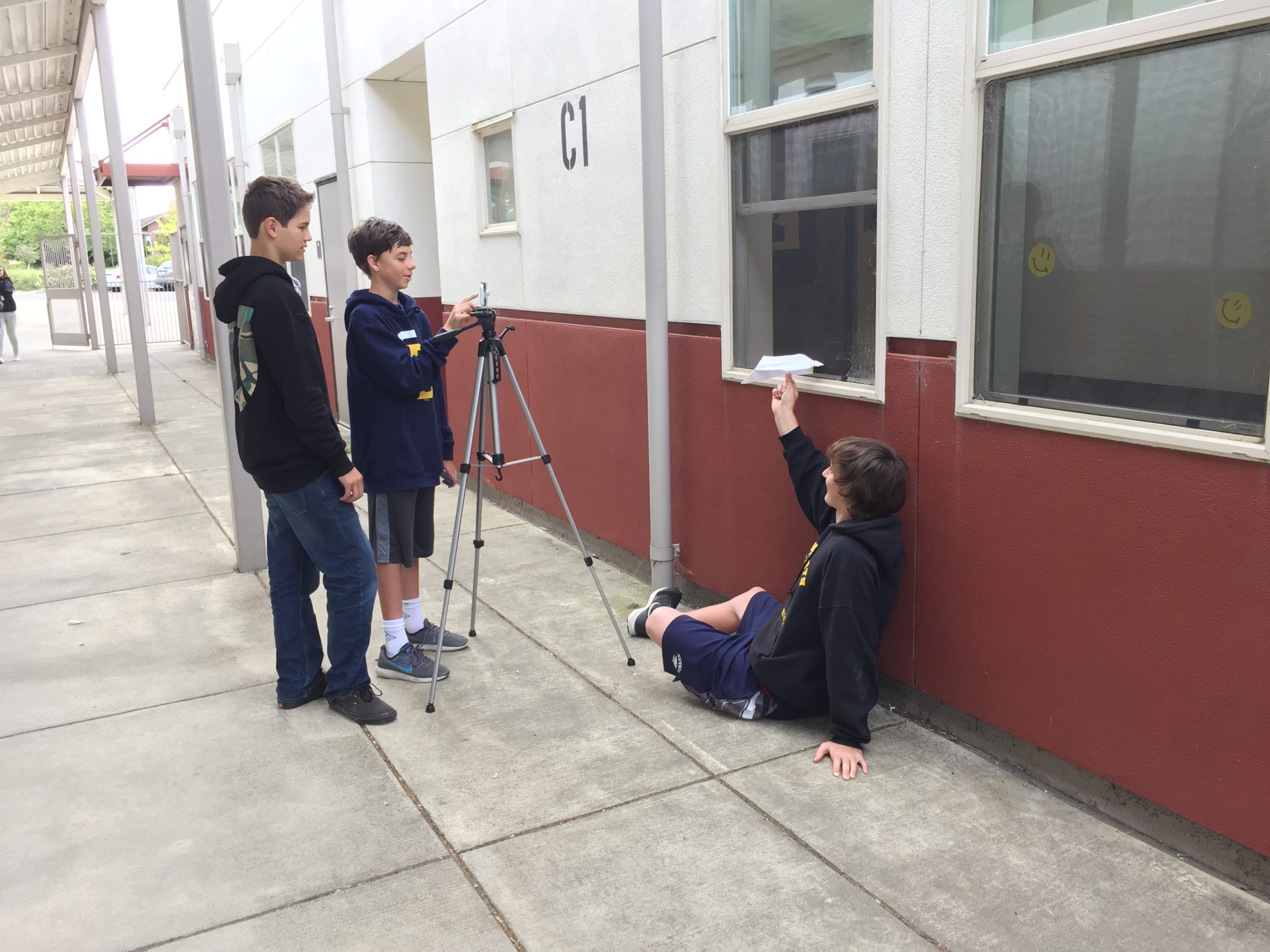
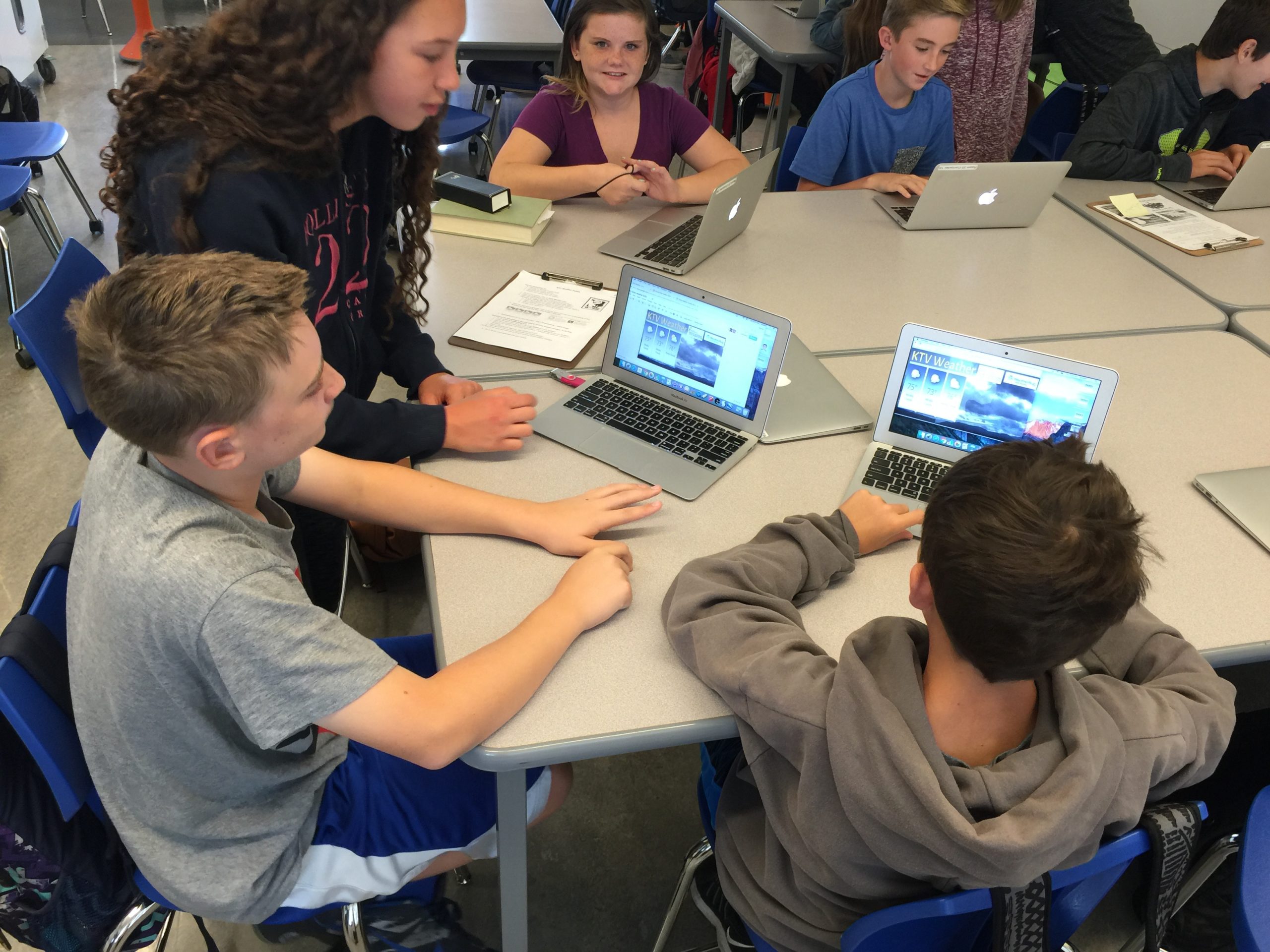
Recently we completed our second year in our new classroom, where we continue to tweak, revise, and fine-tune our program. Our biggest struggle is one we had anticipated: keeping students productive during class. Some jobs require hard work most of the class period (script, graphics, floor manager, producer); while other jobs demand focused attention for the final half hour of class (tricaster, teleprompter, audio, bus, director). But the students responsible for the equipment (cameras, laptops, studio lights/cameras) have very little to do during most of the class period. We have told them they should be working on film production when they have nothing else to do (creating PSAs, for example, about school rules or current issues), but too many students don’t work well in that kind of self-directed environment.
So as our program continues to evolve, we look for more ways to help our students develop those life skills critical not only to their futures, but to their current lives: responsibility, initiative, maturity.
Next year we will divide the jobs into three categories:
-
Production Team: busy all class period, so they won’t have any other assigned work during that job rotation.
-
Tech Team: busy only during filming, so they will be assigned short films to help build film-making skills (angles, narration, green screen, etc.).
-
Equipment Team: busy only at the end of class, so they will be assigned specific PSAs, longer films that should take multiple class periods to film and edit.
When Isaac and I took on the challenge of advising our student news program, we really didn’t know how much we didn’t know! But we both agree that it has been one of the most exciting challenges of our career. And the best part is probably that our students continue to teach us how to look at learning with fresh eyes, to give our students more responsibility, and to let go of the need to be in charge of everything that happens in our classroom.
It’s especially satisfying to see a tiny 7th grade girl call out, “Quiet on the set!”; see the entire class respond appropriately; watch the students produce the entire episode; and hear the joyous, “And that’s KTV!” that signals the end of each show.
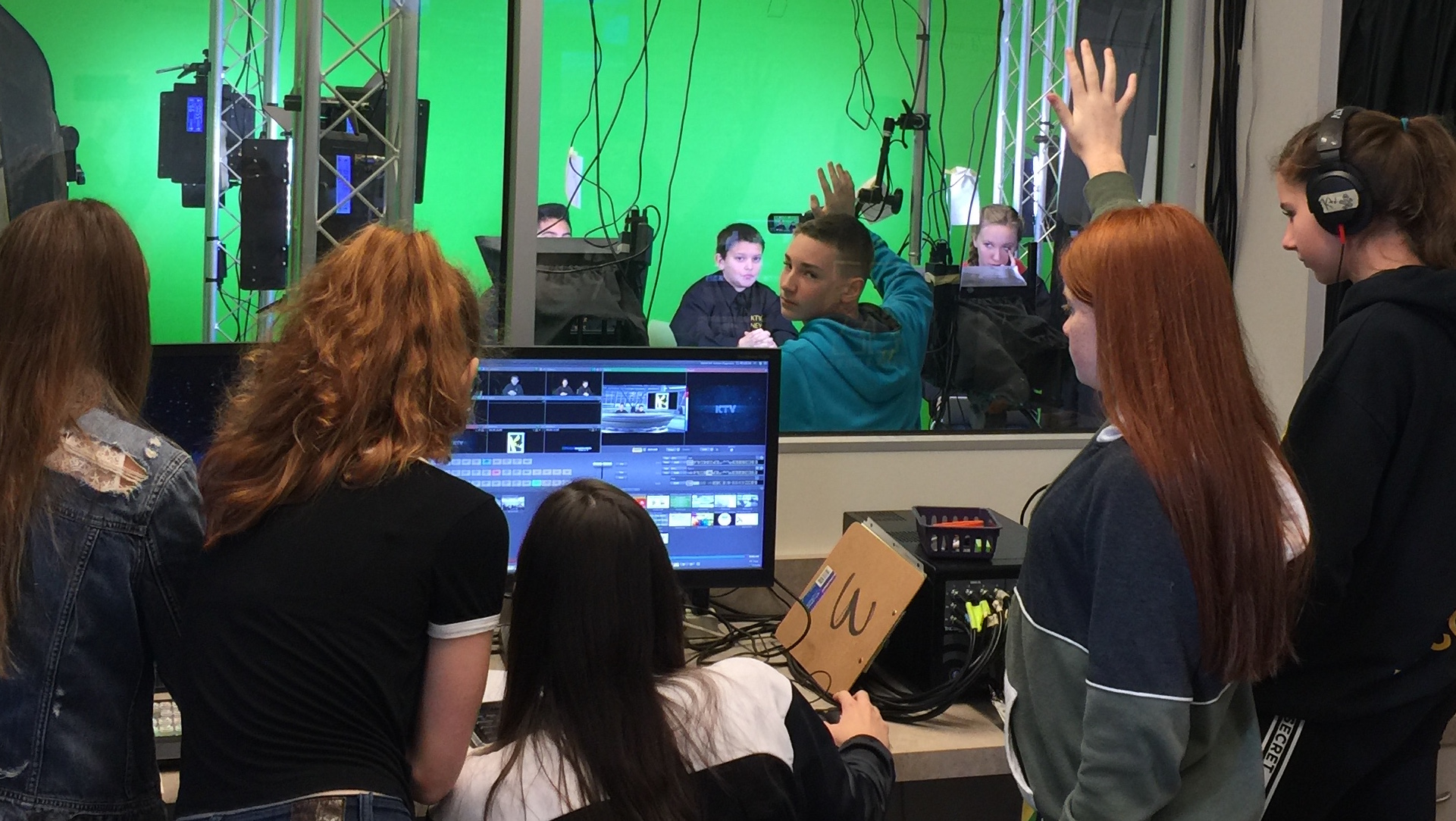
To get a sense of how our class is run, check out this student-made video from our first year in our studio classroom:
When Assignments Become Jobs: The Power of Meaningful Work
When Jordan enters her Broadcast Media class at Kenilworth Junior High School, she doesn’t wait for directions from her teacher. She checks the job board, grabs a laptop and heads to her table to confer with her partner, Kyle. They are anchoring today’s news show, so they will spend the first part of class writing their script. They pull up the class website and navigate to a spreadsheet of announcements submitted by school staff members. They work together on a shared Google doc (also from the website) and coordinate with the weather and sports teams so they can incorporate their reports into their script.

In addition to Jordan and Kyle, there are 31 more seventh and eighth grade students in the class, all assigned jobs in the production of KTV, their school’s daily news broadcast.
-
Studio Managers: set up lights, cameras and teleprompters at the start of class
-
Script/Anchors: write script and anchor news show
-
Weather: research and write weather forecast and make graphics; deliver report on air
-
Sports: research and write sports report and make graphics; deliver report on air
-
Graphics: make graphics for each news item
-
On This Day…Team: research, write, film and edit movies to highlight events in history
-
Film Crew: research, storyboard, film and edit movies (PSAs, school events, etc.)
-
Floor Manager: collect, deliver, and confirm that graphics and videos are loaded on the tricaster prior to filming
-
Producer: organize teams to prep for filming; supervise directors
-
Audio Tech: set up, check and monitor audio for anchors
-
Bus Tech: switch cameras during filming
-
Tricaster Tech: manage videos, graphics, audio and recording during filming
-
Directors: direct anchors during filming
-
Teleprompter Tech: set up and pace teleprompters during filming
-
Equipment Managers: confirm all equipment is shut down and stored after filming
From the time the first bell rings until the producer quiets the class for filming, the KTV room is abuzz with activity. Students move with authority around the room (and across campus), each responsible for elements of genuine broadcast media work. The stakes are high, as the scripts they write, the graphics they design or the movies they edit are not merely “turned in” to a teacher, but are published to a wide and meaningful audience.

Our students know that the next day, during their morning class, they will watch this episode of KTV, surrounded by their peers. That audience alone is significant enough to motivate 12 and 13-year-olds to do the best work they can. But the audience for our students’ work extends well beyond the walls of our classroom — parents and community members also stays up-to-date on school news by accessing KTV from the front page of the school website.
Far more meaningful than grades, the daily publication of the KTV students’ efforts provides a steady stream of feedback, affirmation and ownership, while also strengthening their ability to work in a self-directed environment. The work they do on any given day in the KTV studio is informed by their previous work, as the class critiques the published episodes, discusses what worked and what didn’t, and moves on to the next episode with specific plans for improvement. In addition to building academic skills such as writing, proofreading, presenting and speaking, KTV students practice professional broadcast skills, such as media production and behind-the-scenes technology. And woven through all of their work are skills critical to our professional and personal lives: collaboration, communication, creativity, critical thinking, responsibility, flexibility, and the problem-solving prowess that comes from working under pressure to produce a daily news show in a room full of people and unreliable technology.

In the final half hour of class, Jordan and Kyle wear the official KTV News Team shirts, sit at the anchor desk in the studio, and run through their lines while the teleprompter team paces the script. The producer rounds up the tech team and directors, and checks in with the floor manager to make sure the tricaster and bus tech have coordinated the show’s chronology. She quiets the room for filming and the show is now in the hands of the tech team, anchors and directors. When the show is over, the class applauds and then starts putting away the equipment, while the tech team uploads the show to YouTube and Twitter. Another episode is in the can; just another day in the studio for these kids.

After teaching English for 20 years, taking on the broadcast media class has opened my eyes to the power of giving students jobs with clearly defined responsibilities, meaningful motivation, and wide publication to a significant audience. And it makes me wonder: What if our traditional academic classes looked like this? What if in an English class, my students were given jobs that writers and literary critics tackle in their professional roles? And what if those jobs resulted in frequent publication to a meaningful audience? What about math classes? Can they look more like the workplaces of mathematicians and engineers?
We’ve all heard the favorite student complaint disguised as a question: “When am I ever going to use this in the real world?” Annoying, yes, but a fair question. What if their classes really did operate like the real world? What if students were given jobs instead of assignments and could easily see how the skills they were learning were relevant to real-world work? This teacher is convinced: The real-world question is valid, and we owe our students more than an answer; we owe them authentic, real-world learning opportunities.
Media Equipment is Expensive! Grants Make it Possible
Your school can start a broadcast media program with as little as an iPad. Add a green screen (fabric or paint), and the students can deliver the news from what looks to be a professional studio set. A low-key operation like this is a great way to get students in front of and behind the camera, and to teach them some broadcast media skills.

But the more your news program reflects the equipment found in a professional studio, the better your students’ experiences will be. That equipment is expensive, though!

As we have built our broadcast program, we have written grants and sought donations in order to purchase the best quality equipment (see our equipment list here). While it can be tempting to buy the cheapest, that can end up costing you more. Our lavalier mics are an ongoing issue; we have already replaced some less expensive mics with better ones, and since they are used every day, it’s important that they are sturdy.
It is well worth the time to learn to write grants, as there is a lot of money out there if you can present and argue your case clearly. Here is where we have received funding for our program:
- $20,000: LRNG Innovator “No Bells, No Walls,” 2014
- $4314: DonorsChoose, 2017
- $540: our school’s PTSA, 2016
- $15,000: Petaluma Educational Foundation, 2015
- $700: Kiwanis, 2015
- $3000, our school’s PTSA, 2014
- $855: Kiwanis, 2014
- $581: DonorsChoose, 2013
- $3000: Wells Fargo/SF Giants, “Step up to the plate,” 2012
- $600: our school’s PTSA, 2012
Check out Edutopia’s list of grants and resources, which is updated often.
There is a lot to be gained from giving students access to professional quality media equipment, and even if your school can’t afford to buy it, you can start building a program from scratch by taking advantage of grants.
Media Across the Curriculum: Lessons from a TV Studio
Lizzy was working on a short movie about Women’s History Month for her broadcast media class. Using the “labeled for reuse with modifications” Google search option, she had gathered images to represent women’s accomplishments over the years. Now she was inserting text throughout her film, highlighting the names of pioneering women.
“What do you think?” she asked Bella. “Crafty Girls font or Special Elite?” She turned her laptop so her friend could see her work.
“Oh, not Crafty Girls! That’s way too swirly – doesn’t match the tone of your movie. Stick with something more serious. I like Special Elite – it looks like a typewriter – it goes with those older photos.”

Since Lizzy, Bella and their classmates create media for their school’s daily news show, they have begun to recognize (and use) the strategies that artists, graphic designers, and advertisers use to influence viewers. Prior to this class, most students wouldn’t realize how a particular ad might affect their shopping habits, but now that they are on the other side of the screen, designing media themselves, they are becoming quite savvy about the careful construction and potential uses of media.
Our students navigate a world that is saturated with various forms of media: images on their cell phones, movies on their iPads, text on screens and paper; and GIFs, emojis, and tweets dominate their communications. But passively consuming and sharing media does little to improve students’ media literacy skills. It is in the creation of media that we begin to understand how much media can influence us. When we use the strategies that media-makers use, we view media with new eyes. We become critical consumers, less likely to be swayed by the images that surround us every day.
Media production is a natural part of any broadcast class, as you wouldn’t see a news show that doesn’t include images, videos, and text on the screen. But your students shouldn’t have to enroll in a broadcast class before they discover the power of media production. Engaging your students in media production will not only build their digital literacy skills, but it will offer them a variety of ways to demonstrate their learning.

Here are some resources for incorporating media production across the curriculum:
Worried about learning how to use all these tools yourself? Never fear! Your students will love diving into new apps, and they will especially enjoy teaching YOU how to use them.


